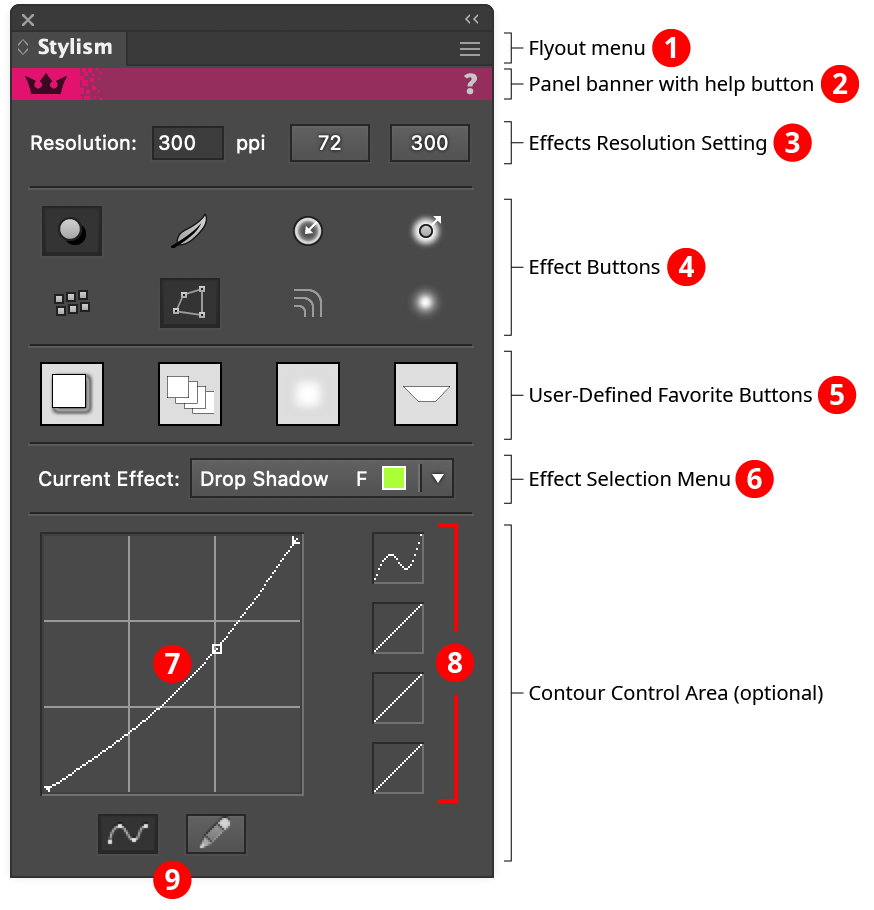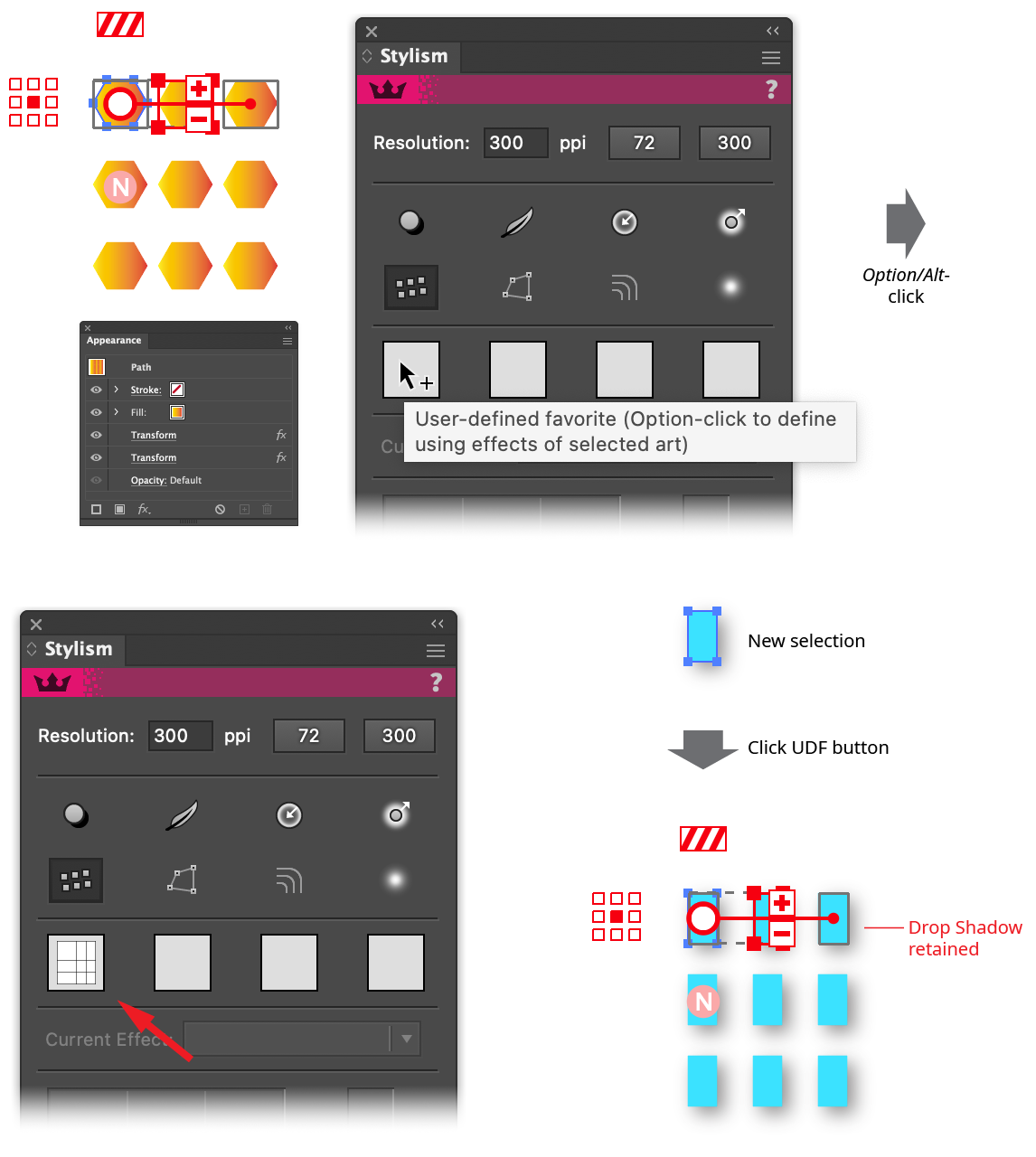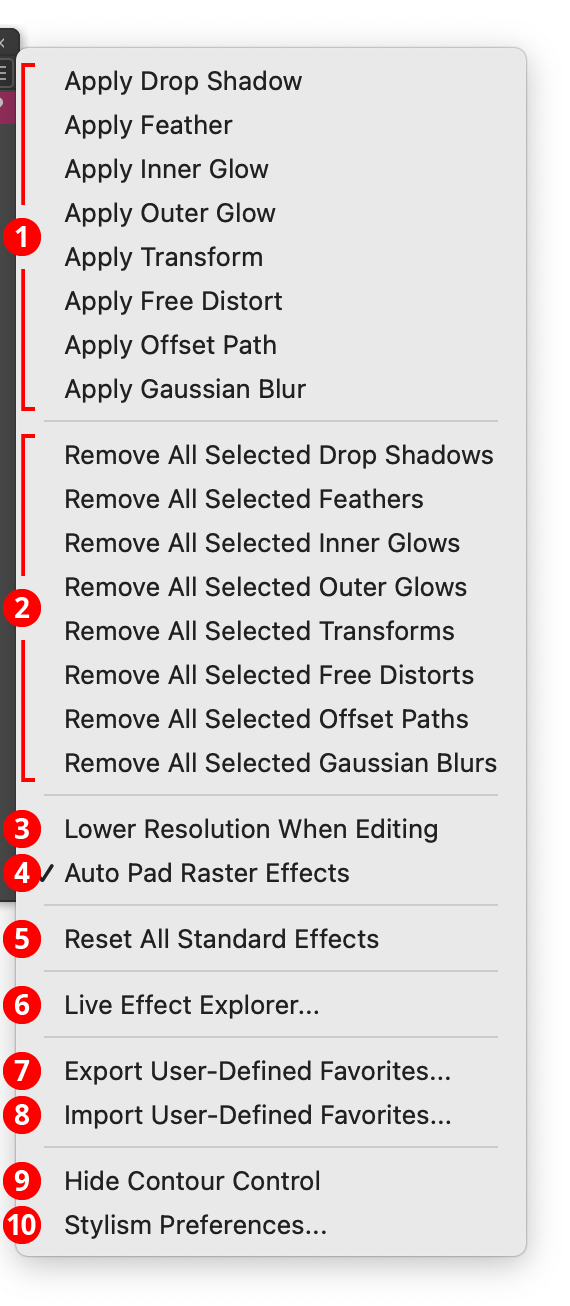 Stylism Panel
Stylism Panel
The menu item to show and hide the Stylism panel can be found in the main menu under Window > Astute Graphics > Stylism.

Stylism Panel
1. Flyout menu
See Stylism Panel: Flyout Menu.
2. Panel banner
The Stylism panel banner has a help button on the right which opens the help documentation in the Astute Manager. If this does not automatically appear, please ensure your Astute Manager is running first. Along with the rest of the panel, the panel banner can be clicked to activate the Stylism tool. This is a quick method of locating the tool within the default Advanced toolbar or a custom toolbar.
3. Effects Resolution Setting
This area allows you to see and quickly change the Document Effects Raster Resolution setting, the resolution at which raster objects produced through live effects (such as Drop Shadow, Feather, Gaussian Blur, etc.) are created. Natively, this is found under the dialog opened through the menu item Effect > Document Raster Effects Settings.... Typically, the resolution is set to a fairly low value (for example, 72 ppi) while working on the document, for speed. Then, when the document is ready to go to print, it is changed to higher resolution (typically 300 ppi or more), for quality.
The new resolution can be entered into the input box, or one of the buttons on the right can be clicked. To customize the resolutions produced by either button, hold down Option/Alt when clicking it.
4. Effects Buttons
The effects buttons are used to quickly add and remove the eight supported native live effects from the targeted art simply by clicking on them (clicking once adds the effect; clicking again removes it).

Stylism Panel Effects Buttons Basics
Buttons which are selected (dark) indicate that its effect is present. The buttons in the first row represent (from left to right): Drop Shadow, Feather, Inner Glow, and Outer Glow; those in the second row represent Transform, Free Distort, Offset Path, and Gaussian Blur.

Stylism Panel Effects Buttons
Effects are added in their default positions (below all strokes and fills, except for the Offset Path effect, which is added above all strokes and fills) and always start with a default set of parameters. Initially, these are the same parameters that would be set when adding the effect natively through the Effect menu. For example, a Drop Shadow is initially given X and Y offsets of 7 pt, a blur of 5 pt, and an opacity of 75%.
However, you can change the parameters that are initially applied when the effect is added using one of the Stylism effects buttons (or flyout menu). To do this, select a single object that has the effect and change its parameters to the desired settings. Then, hold down Option/Alt and click the corresponding effects button. From then on, using the button will add the effect with your custom parameters. (The buttons can have their Illustrator-specified default parameters restored by using the panel flyout menu item Reset All Standard Effects).
Normally, if an effect is already present, then clicking the corresponding effects button again will remove it. To instead add a second copy of the effect, hold down Shift when clicking the button.
Holding down Command/Ctrl when clicking a selected effects button is a shortcut for making it the current effect.
5. User-Defined Favorite Buttons
The user-defined favorite (“UDF”) buttons allow you to save the look of one or more Stylism-controlled effects and later apply it to selected objects. Like a native Graphic Style when using its merge mode, the effects in the UDF buttons do not replace the object’s current appearance but instead add to it. User-
defined favorites are available across documents and Illustrator sessions.
To define a UDF button, there must be only one object selected, and it must contain at least one effect from the eight native effects that Stylism controls. Then, hold down Option/Alt and click the button. The thumbnail image in the button will update, showing the effect(s) as applied to a small square with a white fill and black stroke. Now, clicking the button will add those effect(s) to any selected art without affecting any existing effects. The Stylism tool will be automatically made active (if it is not already).

Stylism Panel User Defined Button Usage
If the selected art already contains the same live effect in the same position as one defined in the UDF button, it will not be replaced. If the UDF button had an effect applied in a stroke or fill and the receiving object has no strokes or fills, the effect will instead be added in its normal position.
6. Effect Selection Menu
This menu is used to switch the current effect (the effect for which the Stylism tool is displaying an annotated UI) when the selected art contains more than one effect, including multiple copies of a single effect. Each effect that is present is listed by name in the menu. Following the name is a code for its position in the appearance stack (as viewed in the Appearance panel):
a. Pre: Effect is above any strokes or fills.
b. S: Effect is in a stroke.
c. F: Effect is in a fill.
d. Post: Effect is below any strokes or fills.
For effects contained in strokes and fills, a small swatch of the color of the stroke or fill is also displayed, to make it easier to select the correct effect.
7. Contour Graph
This graph is available when the Contour Control area is showing, the Stylism tool is selected, and the Astute Graphics’ Phantasm plugin is installed. For use with effects which create an image with an alpha mask (Drop Shadow, Feather, Outer Glow, and Gaussian Blur), it allows you to put a curve on the alpha channel (implemented by automatically adding a matching Phantasm Curves live effect at the bottom of the effect stack). This is most commonly used with the Drop Shadow effect, to achieve a look that can’t be made through changes to the Drop Shadow parameters alone.

Stylism Contour Control Example
The horizontal axis represents the input alpha value, while the vertical axis represents the output value. With the default diagonal line, the two are the same. Nodes on the curve may be moved simply by clicking and dragging them. A new node may be added by clicking at a spot along the curve which does not already have a node. Nodes (except the ones at the beginning and the end of the curve) may be deleted by dragging them off the graph area.
8. Contour Graph Curve Preset Buttons
These four buttons allow you to load and store contour graph curves. Each displays a thumbnail of the curve it contains. To load a graph, simply click on a button. To store the current curve to a button, hold down Option/Alt and click on a button. Curve presets are preserved across Illustrator sessions.
9. Contour Graph Mode Buttons
The contour graph can be created using one of two modes. The left-hand “Curves” button allows editing it as a smooth curve passing through two or more nodes. The right-hand “Pencil” button allows drawing freehand, with the ability to change each value arbitrarily. If a graph is started in pencil mode and later changed to curves mode, the best possible curve will be fitted through the points.
Stylism Panel Flyout Menu
The Stylism panel flyout menu items are contextually sensitive and all items may not be available, depending on the current selection.

Stylism Panel Flyout Menu
1. Apply Effect Items
Each menu item adds the corresponding effect to the selected art, just as clicking on the panel effects buttons would do. If all of the selected art objects already contain the effect in question, the menu item will be disabled. Custom parameters set up through the buttons apply.
2. Remove All Selected Effect Items
Each menu item removes all instances of the corresponding effect from all selected artwork.
3. Lower Resolution When Editing
If the menu has a checkmark next to it, the setting is enabled. When enabled, and a raster-based effect (Drop Shadow, Feather, Inner Glow, Outer Glow, or Gaussian Blur) is edited with the Stylism tool, the Document Effects Raster Resolution setting will automatically be changed to the lower of the two values contained in the buttons at the top of the panel.
4. Auto Pad Raster Effects
If the menu has a checkmark next to it, the setting is enabled. When enabled, and a Gaussian Blur effect’s blur parameter is edited with the Stylism tool, increasing the blur radius to a value that exceeds the native Document Raster Effects Setting “Add [X] Around Object”, then this setting will automatically be increased to avoid clipping, and a warning dialog will be shown (unless it has been hidden with Don’t show again).
5. Reset All Standard Effects
Resets the parameters that are assigned to new instances of the eight Stylism-handled effects (when adding them through the top panel buttons or the first eight panel flyout menu items) to the default values that would be assigned if the effects were added through the Effect menu.
6. Live Effect Explorer...
Opens the Live Effect Explorer dialog (see Stylism: Live Effect Explorer).
7. Export User-Defined Favorites...
Brings up a standard OS save dialog through which the contents of the four user-defined favorite panel buttons can be saved to a .SUDF (“Stylism User-Defined Favorites”) file.
8. Import User-Defined Favorites...
Brings up a standard OS open dialog through which the contents of the four user-defined favorite panel buttons can be imported, by opening a previously saved .SUDF (“Stylism User-Defined Favorites”) file.
9. Hide Contour Control
The bottom area of the panel, showing the contour graph, preset buttons, and mode buttons, can be hidden using this menu item to make the panel more compact. When the area are hidden, the menu item will change to Show Contour Control.
10. Stylism Preferences…
Brings up the Preferences dialog (see Stylism: Preferences).
